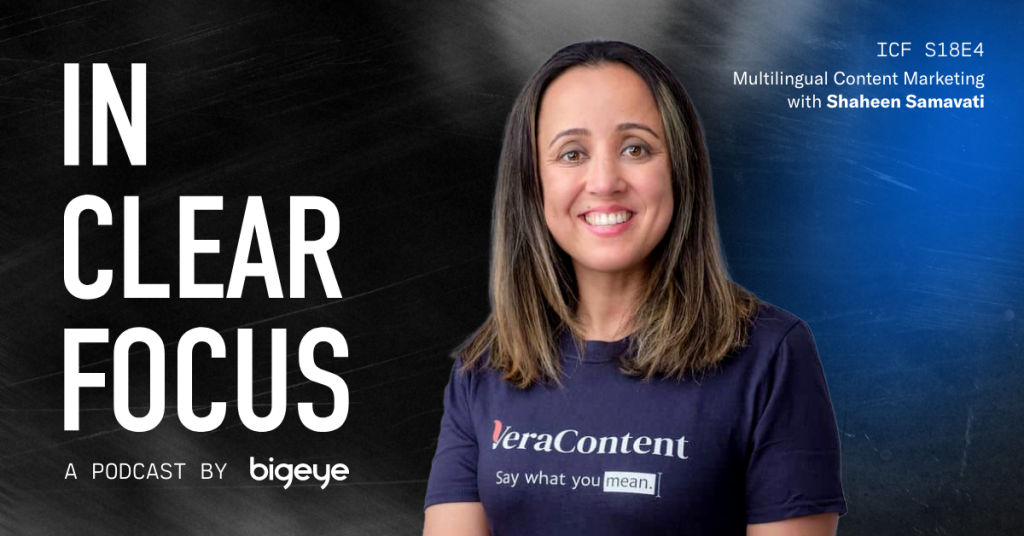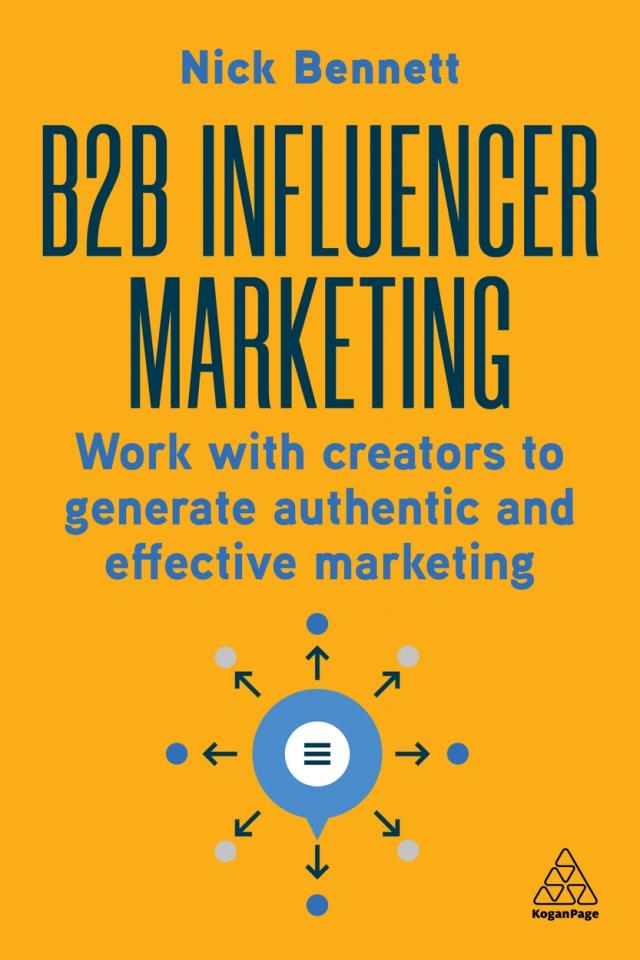
IN CLEAR FOCUS: Guest Shaheen Samavati, CEO of VeraContent, discusses multilingual content marketing. She shares insights on the challenges brands face managing global content, the importance of cultural adaptation, SEO considerations, and AI’s impact on the industry. Our conversation also covers quality control, influencer marketing, and how best to measure campaign success. Learn how Shaheen’s team at VeraContent helps brands navigate the complexities of international content.
Episode Transcript
Adrian Tennant: Coming up in this episode of IN CLEAR FOCUS
Shaheen Samavati: A recent misconception maybe is about how much of the heavy lifting can actually be done by AI. I mean, it takes away a lot of the tedious tasks, but the thinking still has to be done by humans, and you can’t just let AI think for you because it ends up producing not very good content.
Adrian Tennant: You’re listening to IN CLEAR FOCUS, fresh perspectives on marketing and advertising produced weekly by Bigeye, a strategy-led full-service creative agency growing brands for clients globally. Hello, I’m your host, Adrian Tennant, Chief Strategy Officer. Thank you for joining us. As brands expand their global footprints, creating content that resonates across different markets while maintaining consistency has become increasingly complex. The challenge isn’t so much in translating content as it is about understanding cultural nuances, local consumer behaviors, and delivering authentic experiences across multiple platforms and languages. Our guest today is an expert in helping brands navigate exactly these challenges. Shaheen Samavati is the co-founder and CEO of VeraContent, a multilingual content marketing agency that manages global social media and content marketing channels for international brands. Originally from Ohio, Shaheen began her career as a business journalist here in the United States, writing for publications including The Wall Street Journal. After moving to Spain and completing an MBA at IE Business School, she worked in corporate communications before founding VeraContent. Under her leadership, the company has grown to employ a core team of in-house staff members who collaborate with over 200 hand-picked freelancers to create and adapt marketing content in more than 20 languages. To discuss multilingual content marketing and how brands can effectively engage global audiences, I’m delighted that Shaheen is joining us today from Málaga, Spain. Shaheen, welcome to IN CLEAR FOCUS!
Shaheen Samavati: Thanks for having me. Great to be here.
Adrian Tennant: Before we dive into multilingual content marketing, could you tell us about your journey from journalism to founding VeraContent? What inspired that transition?
Shaheen Samavati: Yeah, so definitely my background as a print journalist had a huge impact on all of my career choices after that and my decision to start VeraContent, the agency. But yeah, I’m originally from Ohio, so I worked there as a newspaper journalist right out of university, and that was my first job. So I had the unique opportunity to work at newspapers when they were still, I guess, in their heyday or towards the end of it. So I think that opportunity to work in a large newsroom, getting a lot of collaboration and feedback from other journalists, and we had a very stringent editorial process that we went through to put any piece of content out. And I think that was really unique compared to what content production looks like nowadays, now that everything is online, practically. We were writing for print, so you had a deadline every day at a certain time, and every piece of content had to go through several people before it could make it into the newspaper. And now a lot of things are just like created and put it out there. So that editorial experience like had a huge impact. So basically, my story is I came to Spain to do an MBA after four years working in journalism. And after the MBA, I started working in corporate communication marketing here in Spain. I worked in a few different companies in the solar energy and renewable wind farms as well. So yeah, I was doing some corporate communication work. And then I worked in marketing in a real estate company. So a bit of a change. But in all those experiences, I basically saw that the content production process in corporates or startups is completely different than what I used to do in the newspaper. So kind of my impetus for starting VeraContent was to bring quality editorial processes back to content creation. And that’s what we’ve been working to do. And we work with global brands, both from US and Europe, mainly focused on European markets to create multilingual content, quality content across markets.
Adrian Tennant: Shaheen, what are some of the biggest challenges brands face when managing content across multiple markets and languages?
Shaheen Samavati: Well, I think going back to what I was talking about, the editorial processes, I think a lot of brands’ marketing teams lack clear processes for content creation, especially when working in a lot of different international markets. You might have a lot of different people involved in that and doing things in completely different ways. And so I think a lot of times clients come to us feeling like they have a lack of control over the messages that are being put out into the world online, especially on social media, because that’s such I mean, I think social media is something that was a bit of an afterthought maybe 10 years ago. And a lot of pages were created and content was being put out there. And maybe you had one salesperson in one market running one social media page and an intern in another market doing something else, or some partners who created a page. And I think a lot of clients come to us saying, like, “I have this mess of different things happening on social media, and we really need to have some control over it. Because now we realize how important social media is. And we’ve created this global head of social media.” Oftentimes that’s the person who’s coming to us saying, “OK, it’s my job to make sense of this. Can you help me?” That’s what we do.
Adrian Tennant: How should brands approach the decision to expand their content into new markets?
Shaheen Samavati: We actually did a webinar on this topic, and we’re going to be doing another one soon, that’s like how to approach a strategy when you’re thinking about, especially, social media content and how to decide where to put your resources. Because if you want to do content on the same level everywhere, it can get costly. And also, it oftentimes doesn’t make sense to do that. Because if you start with 20 markets, but you haven’t got it right yet in any of them, then you can waste a lot of resources that way. So we usually advise to make sure you have a strategy that works in at least one market before you start duplicating it, because that’s really duplicating your costs. And you’re kind of amplifying what you’re doing in one market when you put it into more. I would say that clients who come to us are usually pretty clear on the markets they want to be in, the size companies that we work with, because we work with mid to large companies who are already operating internationally. So they kind of know their markets and their business strategy, but maybe need feedback on the content strategy and where they should be putting their content efforts. And I think some factors to consider, obviously your business goals, which I said often, they’re pretty clear on that. But then I think it’s like where your audience is in each market, which platforms they’re using, where they spend their time, your level of existing market presence, maybe what content you already have in those markets and what’s working and what’s not. Also, of course, your budget and your resources and what you can afford to do. And then, yeah, your current performance in those markets as well. And when it’s like that situation I was saying where they kind of have a mess of social media accounts in the different markets, we usually start with an audit. So we look at, yeah, what are they currently doing in all the different markets and help them prioritize where it makes sense, which pages to keep, which pages maybe to phase out or merge and where to put all the resources. But I think it’s, of course, varies depending on all the factors of each business.
Adrian Tennant: Well, regular listeners know we love case studies on IN CLEAR FOCUS. So Shaheen, could you walk us through how you help a brand develop a global content strategy while maintaining local relevance?
Shaheen Samavati: We work with a company called OverDrive, and they have a brand called Libby, which is an app for downloading library books. Their clients are actually the libraries, but they need users to use the app for the libraries to buy it. So the target audience for social media are the library users. And they had a really strong presence in the US, so that’s their main market, and they’re really well-known in the US and really well-adopted by library cardholders. And they wanted to duplicate that. I mean, basically their goal for social media in the markets that they hired us for, which were Germany, the UK, and Australia, and New Zealand, was to raise awareness for the app and drive usage. So basically when we start with any new project, it’s evaluating what’s currently working for them on social media in the markets that they’re in, and then how we can adapt that for the different markets, and we create a proposal around that after doing a strategy workshop with the client. And so basically we propose a tailored strategy for each of those markets and taking into account of course the fact that the awareness of the app was a lot lower in those markets. So we define like content pillars, so the different areas of content, like categories of content basically that we would like regularly create. And so, yeah, we had some pieces of content that we’re doing more frequently for those markets that were basically, what is Libby and kind of how can you use the app? And then we also work with them to create a strategy to work with local influencers and local partners, basically libraries, like a lot of, we proposed because like so many libraries, of course, have Instagram channels. So the focus of this was Instagram, by the way. So this is all on Instagram. But yeah, a plan for how we would reach out to those libraries and do content collaborations with them. Because I think it’s so important at that early stage when you’re launching a channel in a new market is growing your following there. And when you’re starting from zero, it’s a bigger uphill climb. So yeah, and so that’s something we’ve been working with them about a year now. And actually, Australia and New Zealand, we’ve more than doubled follower growth across the markets. But Australia and New Zealand, where they already had a decent following, because that one existed before, we five-timed the follower growth there. And then, yeah, I mean, the numbers actually sound like crazy because we started with very low followers in the other markets, so it was even bigger. But yeah, and then we’ve been growing engagement and reach as well. So it’s been a really successful campaign and we’re planning to launch some new markets with them as well.
Adrian Tennant: Excellent. Now, when it comes to international search engine optimization or SEO, what are some key considerations for brands targeting multiple markets?
Shaheen Samavati: Well, basically we approach SEO for international markets really similarly as you would for a single market. The main difference is that you’re working with different languages and you have to do not only different languages, but different vocabulary as well, because you might work across different markets with the same language, but that they use different words and might use different search terms. So it’s basically unique SEO research for each of the markets that you’re in. Like a lot of the projects we do have like the content is originally created in one language and then we do SEO research in the additional languages and we propose similar topics or even maybe the same article essentially but reworking it with taking into account the keywords that would be used in that market.
Adrian Tennant: Interesting. Could you share an example of a campaign that required significant cultural adaptation and how your team approached it?
Shaheen Samavati: Yeah, so all of them, basically all of our projects! I mean, if we’re talking about SEO, I mean, we’ve done a lot of different SEO projects, but one that comes to mind is like a real estate project platform that we were working with called Spot A Home. They’re a rental platform, so they have landlords and tenants. and they create content for both. But we had a particular project that was for landlords and writing about a lot of topics that landlords would search for when renting out their properties. And that required a lot of adaptation because it had a lot to do with landlord-tenant laws. This was for seven different European markets, and they were quite different in each of the markets. So not only was it obviously the SEO keyword research and the terms that are used across those markets, we actually had to write different content because the situations would be different as well. But then also there’s lots of creative adaptation we had to do for a lot of different projects. I actually worked with a client called Spain Media, which does magazines. I’d say some of the most intricate cultural adaptations are these kind of editorial content, like we translated Condé Nast Traveler magazine. We also translated New York Times Style magazine from English to Spanish. And some of those articles are just really, yeah, like these cultural topics and about art and about food and all those kinds of terms take a lot to translate. And we also worked with Sony Music Spain to translate pop songs—for example, this song from Nathy Peluso. And we basically did the English subtitles for the music video. And yeah, it’s like translating poetry. It’s a totally different ballgame. But, of course, it’s a total adaptation and requires a lot of creativity.
Adrian Tennant: It’s fascinating. How do you manage the quality control process when you’re working with so many different content creators across different markets?
Shaheen Samavati: There’s two aspects of that. One is talent selection, having a really strong talent selection process. And the second is the editing process, like I was talking about before. But for us, this is the core and the secret sauce, I think, of our success, is the processes that we’ve created for this. And so it’s hard to explain it all succinctly. But basically, it’s finding the right people for the projects in the first place, and then giving them really, really clear instructions of the expectations we have from them. And, of course, when you’re working across multiple languages, you need to have rockstar editors in each of the languages because they’re key people that you have to make sure that everything else is of the high quality that we expect. And then, of course, we have ways that we test them and are constantly finding the best talent for the projects. And we also have a rating system to be able to keep track of who our strongest linguists are across the languages. But then we also have what we call our three-step editorial process. But I think that the key in the editorial process is not just the number of steps, but also the quality of the feedback. Because I think that’s what’s really different about our process is that we really require people to give qualitative feedback, not just edit it and move it to the next stage. You have to go back and talk to the person who did the work and tell them what they did well and what they didn’t, because that I think, really motivates a person to be invested in the work that they do. I think it’s so easy to just submit a piece of content, it moves on, and you don’t really think anyone’s paying attention to it or cares. So that’s really core to our philosophy at VeraContent, to have a collaborative culture of feedback, and we’re constantly showing people, like, we care about what you’re doing, and we are paying attention.
Adrian Tennant: So high-tech and high-touch.
Shaheen Samavati: Yes. Yeah, definitely a bit of both. But of course, the human element of what we do is huge. So we’re, of course, I know you’re going to ask me about AI. I’m sure that’s coming. Everyone asks about that. And of course, we’re leveraging that, but we leverage our human talent above all.
Adrian Tennant: Let’s take a short break. We’ll be right back after this message.
 | Nick Bennett: Hi. I’m Nick Benett, author of “B2B Influencer Marketing: Work with Creators to Generate Authentic and Effective Marketing.” My book provides a practical guide for business-to-business brands looking to partner with creators who align with their brand values and can help deliver real business results. I break down key concepts and explain how to develop effective Influencer marketing strategies, from identifying the right partners to measuring campaign success. Whether you’re new to B2B influencer marketing or looking to enhance your existing programs, this book offers actionable insights and frameworks to help you succeed. I hope my book helps you transform your B2B marketing strategy with the power of authentic creator partnerships. Thank you! |
Adrian Tennant: Welcome back. I’m talking with Shaheen Samavati, the founder of VeraContent, about multilingual content marketing. Let’s talk about influencer marketing. Shaheen, how do you manage influencer campaigns in different markets?
Shaheen Samavati: Yeah, so we have community managers who are the people running the local accounts in each of the markets. And part of their job is to know who the important influencers are in the niche for any particular client. And it also depends on the particular client and what they want. But like in the case of Overdrive, like I said, we mostly are doing brand collaborations. The influencer budget is something that would be needed if you want to like do paid influencer campaigns, which we’ve done a lot of as well. For example, we work with a brand called St. Delphor. It’s a fruit spread actually. how they market it, and we’ve done a lot of influencer campaigns with them, basically. But it’s been mostly micro-influencers, I should say. Like, we work with, for example, food influencers, people who are doing different recipes, and we get them to incorporate the jam in the recipe and show how they do that. We’ve also worked with lifestyle influencers, so that are maybe They’re more focused on home decor, on fashion, but they can work the jam into a scene and recommend it to their audiences. And that’s actually an interesting aspect of that client, is that they really want to be seen as a high-end fruit spread. So that’s been interesting, finding the influencers that really match with their brand.
Adrian Tennant: I’m curious, how do you measure the success of multilingual content campaigns? I’m wondering what metrics matter most when evaluating international performance?
Shaheen Samavati: Yeah, and that’s an interesting question. I’d say that it depends on… It depends. That’s the answer to everything. But like I mentioned before, we have a strategy workshop that we do at the beginning of new projects. And that’s where we establish with the client what their goals are for the project. And those goals can vary quite a lot depending on the specific project. Like in the case of Overdrive, like I said, they were focused on follower growth and engagement because they wanted to raise awareness of their app in those markets. It could vary. For example, we work at the university and that’s a lot about getting people to certain stages of the student journey. Certain content that we create is what we want them to click on this particular thing so that they move to this next stage. It really depends.
Adrian Tennant: Could you share some common misconceptions that you’ve come across about content localization?
Shaheen Samavati: There’s probably a lot of misconceptions out there. I think, though, most of the clients we work with understand content pretty well. And I guess a recent misconception maybe is about how much AI can actually do, how much of the heavy lifting can actually be done by AI. It takes away a lot of the tedious tasks, but the thinking still has to be done by humans. And you can’t just let AI think for you because it ends up producing not very good content.
Adrian Tennant: In what other ways is AI impacting multilingual content creation and localization?
Shaheen Samavati: Well, it’s impacting a lot, of course. It’s completely changing the industry of content creation. Talking about generative AI and things like ChatGPT or Gemini that can actually create text. Yeah, I think it’s like an expectation now that content creators leverage these tools to be more efficient. So it’s been a challenge to figure out how can we leverage these tools without impacting quality. I think there’s fear all around, both from the people creating the content are afraid it’s going to take their jobs away. So there’s some resistance to using it. Then there’s fear from those who are assigning out the content, thinking that people are going to rely on it too much. So it’s been like the challenge of finding that balance. And I think we’ve been doing a good job of doing that. We’ve really put a lot of emphasis on this over the past few years. We’re creating processes and setting expectations with the team, and this is how you use it, this is how you don’t use it. And for every project, explaining how you can or can’t use AI and giving specific guidelines on which kind of prompts you should use and which situation and all this. So I think to use AI responsibly, it does require a lot of processes, as I mentioned before. And as I was saying, I think that’s a lot of our clients rely on our expertise in creating these types of processes. So it’s been a learning, but I think it’s something that I’m very optimistic about how AI is going to help us and actually help us be more creative and focus on doing the fun part of the work and free us up from some of those more tedious tasks.
Adrian Tennant: Love that. At Bigeye, we work with a lot of CPG brands, from well-established ones to startups and scale-ups. What advice would you give to consumer product brands’ marketing teams, just starting their international expansion?
Shaheen Samavati: Well, I guess I would go back to that point of don’t do it too fast. Because I do find that a lot of times startups do come to us and say, we want to enter these 20 markets at the same time. And I think it makes sense to start small and expand if you can. I know that it’s not always possible in the startup world. because there’s like investor expectations and all that, but at the same time I’ve seen it can be like a big waste if you just get it wrong and do it wrong on such a massive scale. So make sure you get it right in a few markets first and then see what works and doesn’t. Have a couple of test markets, try a few different things, make sure that you’re adapting for those markets and see what might be able to carry over, what might have to be done completely differently in the different market before you try to do too much at the same time. There is a lot of moving pieces and a lot of things involved when you’re creating content on that kind of scale.
Adrian Tennant: Shaheen, what trends are you seeing in how consumers engage with localized content across different social platforms?
Shaheen Samavati: I think the importance of localization is increasing, especially for consumer brands, because we see how much actual user behavior is impacting the content that they’re served up. If they’re interacting with a certain type of content, they’re going to get more of that type of content. And of course, that comes down to really local things, of course, the language and their preferences. And so I think if you want to show up in people’s feeds, you have to be creating the kind of content that they want to see. And so that means taking into account everything about them and the kind of content they’re currently engaging with.
Adrian Tennant: Shaheen, if listeners would like to learn more about your work at VeraContent, what’s the best way to do so?
Shaheen Samavati: So definitely, they can go to our website, VeraContent.com. And I especially recommend our Resources page, which has our Ultimate Guide to Social Media, as well as upcoming webinars on similar topics. And then, yeah, they can also connect with me on LinkedIn, Shaheen Samavati.
Adrian Tennant: Great conversation. Shaheen, thank you very much for being our guest this week on IN CLEAR FOCUS!
Shaheen Samavati: Thank you. It was great to be here.
Adrian Tennant: Thanks again to my guest this week, Shaheen Samavati, co-founder and CEO of VeraContent. As always, you’ll find a complete transcript of our conversation with timestamps and links to the resources we discussed on the IN CLEAR FOCUS page at Bigeyeagency.com. Just select ‘Insights’ from the menu. Thank you for listening to IN CLEAR FOCUS, produced by Bigeye. I’ve been your host, Adrian Tennant. Until next week, goodbye.
TIMESTAMPS
0:00: Introduction to AI and Content Creation
0:16: Welcome to IN CLEAR FOCUS
0:38: The Complexity of Global Content Creation
1:10: Meet Shaheen Samavati
2:21: From Journalism to VeraContent
4:18: Challenges in Multilingual Content Management
5:27: Strategizing Market Expansion
7:17: Case Study: OverDrive and Libby
10:03: International SEO Considerations
10:55: Cultural Adaptation in Campaigns
12:38: Quality Control in Content Creation
14:19: Balancing Technology and Human Touch
15:40: Influencer Marketing Across Markets
17:17: Measuring Success in Multilingual Campaigns
18:08: Misconceptions About Content Localization
18:38: AI’s Impact on Content Creation
20:16: Advice for Consumer Brands Expanding Internationally
21:11: Trends in Localized Content Engagement
21:51: Learning More About VeraContent
22:15: Conclusion and Thanks


